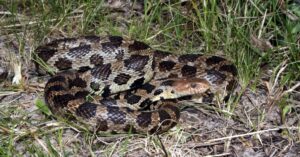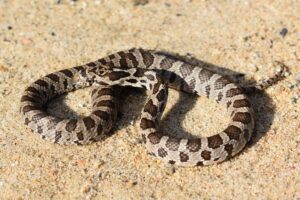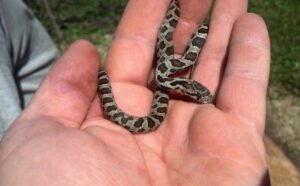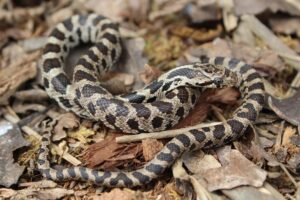The western fox snake or western foxsnake is a species of rat snake in the Colubridae family. The specific name ramspotti is in honor of the aspiring herpetologist, late Joseph Ramspott.
Before 2011, when P. ramspotti was proposed as a new species, it was thought to be the same as P. vulpinus, and the latter was sometimes referred to as the western fox snake. A 2011 paper by Crother, Graham, Eckstut, Savage, White, and Gardner proposed that the Mississippi river be considered the boundary for dividing the 2 species of fox snakes. So those found to its west were given the new name P. ramspotti or western fox snake. Those living to the east of the river came to be known as P. vulpinus or eastern fox snake (including those snakes previously known as P.gloydi).
Scientific Classifications
- Suborder:Serpentes
- Family:Colubridae
- Genus:Pantherophis
- Species:P. ramspotti
Conservation Status
Description
Size
They attain a length of 36-54 in (0.91-1.37 m).
Color and Appearance
The background body color is greenish, yellowish, tan, or brown, with an average of 37 large, distinct brown blotches on the back and smaller ones at the sides. The head may have some shade of orange. The belly is usually yellow with a prominent black checkered pattern.
Are They Dangerous to Humans
The fairly bold snake travels close to humans and other animals if undisturbed. When confronted, it “rattles” its tail, mimicking a rattlesnake, in an attempt to deter its predator. It can also take an “S” posture ad snap fast in succession. These are all defense measures adopted by the snake to allow it to escape to safety. If captured, it releases a musky odor resembling the scent of a red fox. This accounts for its common name.
Western Fox Snakes at a Glance
Distribution
It is a native of the upper midwestern US, west of the Mississippi river.
Habitat
The western fox snake is found in various habitats, both natural and disturbed. Its preferred natural habitats are grasslands, forest shrublands, and freshwater wetlands. On the other hand, the preferred disturbed habitats include old fields, pastures, and other farmlands.

Lifespan
Western foxsnakes live for around 12-20 years.
Predators
It falls prey to foxes, coyotes, and hawks.
Diet
The constrictor preys on mice and other small rodents. It also eats frogs, eggs, and small rabbits.
Reproduction
Oviparous (lays eggs that hatch outside the body)
Clutches of 6-29 eggs are laid in humus under logs and in old stumps in June or July. They hatch after 2 months. The hatchlings resemble western rat snakes and are about 1 ft (30.5 cm) in size.
Source
sdherps.org, psychoticnature.com, a-z-animals.com








